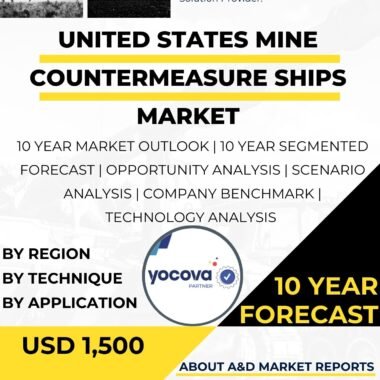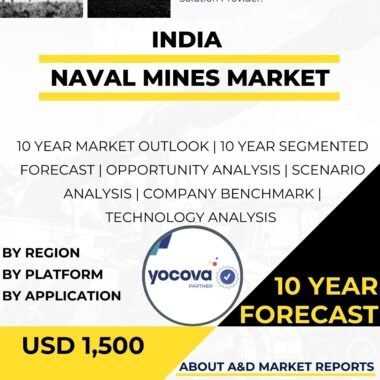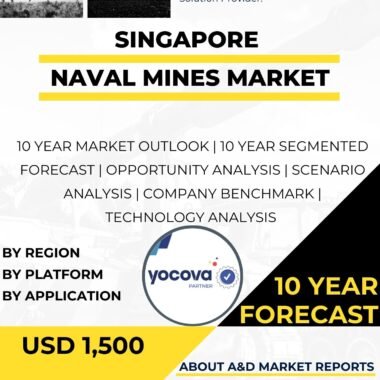Description
The naval mines market in France reflects a deeply entrenched yet often understated aspect of the nation?s naval defense capabilities, encompassing both offensive and defensive applications that have remained strategically relevant despite the advent of modern missile and surveillance technologies. Naval mines, in their essence, are explosive devices placed in water to damage or destroy enemy vessels, but in contemporary doctrine they no longer represent simple static weapons. They have evolved into highly sophisticated systems that integrate advanced sensors, triggering mechanisms, and even autonomous features allowing selective targeting of adversary vessels. For France, with its expansive maritime borders, overseas territories, and pivotal role as a European naval power, the naval mine market has enduring military and strategic importance. These systems serve as powerful tools for area denial, sea lane restriction, coastal defense, and strategic deterrence. At the same time, France?s industrial ecosystem dedicated to mine countermeasures ensures that it maintains not just the offensive capacity to deploy naval mines but also the defensive expertise to detect, neutralize, and clear them, demonstrating a balanced approach to maritime security.
Historically, France?s involvement with naval mines dates back to conflicts in the late nineteenth and twentieth centuries, when the technology was relatively rudimentary and aimed at deterring hostile fleets from approaching coasts or choke points. During both world wars, European naval theaters saw extensive employment of mines, and France recognized their importance in both protecting harbors and restricting adversarial naval mobility. Post-war developments during the Cold War era transformed naval mine technology globally, and France remained attentive to these trends as it modernized its navy. French defense authorities understood that even though high-tech missiles were transforming naval warfare, cost-effective and stealthy sea mines retained value as force multipliers, especially in littoral defense scenarios. Parallel to offensive mine programs, France also prioritized counter-mine technologies, particularly given the global rise in mine warfare threats seen in conflicts around the Persian Gulf. This dual focus led to innovations in underwater detection, advanced mine-hunting vessels, and autonomous mine clearance systems, ensuring that French expertise in this field would remain comprehensive and technologically cutting edge.
The characteristics of contemporary French naval mines can be summarized through adaptability, selectivity, and electronic sophistication. Adaptability refers to the design of mines that can be deployed across varied maritime environments, shallow coastal waters, chokepoints, and deeper seas, adjusting to conditions through programmable settings. Selectivity highlights the fact that modern French mines can distinguish between friendly and adversary vessels, ensuring reduced risk of accidental detonations and maintaining tactical control. Electronic sophistication is perhaps the defining characteristic of the modern era, as mines are integrated with sensors, electronic fuzes, and triggers that can respond to specific acoustic, magnetic, or pressure signatures. These developments underscore how French engineers have transformed the naval mine from a passive weapon into an intelligent, controllable asset designed for twenty-first-century maritime doctrines. Some systems also employ self-neutralization features, reducing long-term risks to civilian shipping and making them more aligned with international law and humanitarian considerations.
The industrial ecosystem supporting this market in France identifies both major defense contractors and smaller, highly specialized firms. Large defense companies integrate naval mine technology into broader systems of maritime warfare, ensuring alignment with surface and submarine deployment capabilities. Shipbuilding corporations contribute by equipping vessels with mine deployment and clearance systems, making French naval vessels adaptable to multiple combat scenarios. Specialized firms focus on the precise engineering of sensors, underwater electronics, and explosives tailored for naval mine applications. Academic institutions and naval research centers support ongoing innovation through hydrodynamics studies, sonar research, and advanced materials science, ensuring that mine designs remain up to date with global developments. Additionally, government naval authorities, through tests and joint exercises, provide critical feedback, ensuring the refinement of technologies based on practical deployment scenarios. France?s insistence on sovereign development of such systems aligns with its broader defense doctrine, ensuring independence from foreign suppliers for critical areas of naval warfare technology.
The economic and strategic importance of naval mines in France is considerable, even if the subject remains less visible compared to higher-profile defense platforms. Strategically, mines offer low-cost solutions that carry outsized potential effects, capable of denying access to adversaries and complicating naval planning. They significantly enhance asymmetric warfare capacities, allowing smaller naval forces to constrain larger adversaries through carefully laid minefields. For France?s global naval doctrine, which covers both Atlantic and Indo-Pacific responsibilities, naval mines expand tactical options, from protecting overseas territories to influencing contested maritime spaces abroad. Economically, naval mine development supports specialized engineering sectors involved in underwater technologies, electronics, and explosives. Additionally, exports of related technologies contribute to defense diplomacy, as allied nations seek reliable partners for both mine and mine countermeasure capabilities. France?s dual reputation in offering offensive systems and sophisticated clearance solutions gives it leverage in global naval markets while strengthening trust with partner states.
Emerging trends are shaping the naval mines market in France in significant ways. Autonomy is one of the most transformative, as future mines are increasingly being designed with autonomous operating modes that allow them to reposition, adapt to environmental conditions, or form part of swarming minefields coordinated digitally. Networked systems form another trend, where communication between mines or integration with wider surveillance networks allows fleets to monitor, arm, or deactivate mines remotely, offering both flexibility and control. Miniaturization of sensors and advances in energy storage are increasing the longevity of mines while reducing detectability. Sustainability considerations, particularly their eventual neutralization after a period of deployment, are also becoming critical as concerns about long-term hazards to civilian maritime traffic persist. France is integrating self-deactivation and environmentally safer explosives into its designs, aligning with international norms while maintaining operational effectiveness. Another important trend is the convergence of mine technologies with unmanned systems, as AUVs can now carry and deploy mines or themselves act as mobile mine units, adding a completely new dimension to naval warfare.
Security and sovereignty remain critical concerns in this market as naval mines and their countermeasure systems are both strategically sensitive and heavily regulated under national and international defense frameworks. France maintains strict control over the circulation of mine technologies, ensuring they remain accessible only to trusted forces within secure supply chains. Export policies are carefully managed, and all deployments must comply with France?s legal obligations while balancing strategic utility against humanitarian risks. Cybersecurity has emerged as a new sphere of concern, as mines increasingly incorporate programmable features that could be vulnerable to interference if not robustly protected. France has taken steps to secure command and control links associated with modern naval mines, ensuring they cannot be tampered with or remotely disabled by adversaries. This emphasis reinforces sovereignty in underwater capabilities, deemed essential for a nation depending on maritime deterrence and overseas commitments.
Looking ahead, the naval mines market in France is expected to grow in relevance as maritime environments become increasingly contested and as new technologies open further operational possibilities. The modernization of mine deployment systems for France?s next-generation submarines and surface fleets will ensure naval mines remain embedded within strategic planning. At the same time, continued investments in mine countermeasure vessels and autonomous clearance systems will balance the doctrine, keeping France both an offensive and defensive leader in mine warfare. Future innovations will likely focus on smart, networked mines capable of selective engagement, dynamic deployment, and integration into larger digital battlespaces. As global navies rediscover the strategic effect of sea denial through mines, France?s balanced emphasis on sovereignty, cooperation, and innovation ensures it will remain a leader in shaping the direction of this evolving technology area. Naval mines, though often hidden beneath the sea, remain one of the silent guarantors of French naval deterrence, combining low visibility with high strategic payoff in ways increasingly vital to future maritime strategy.




